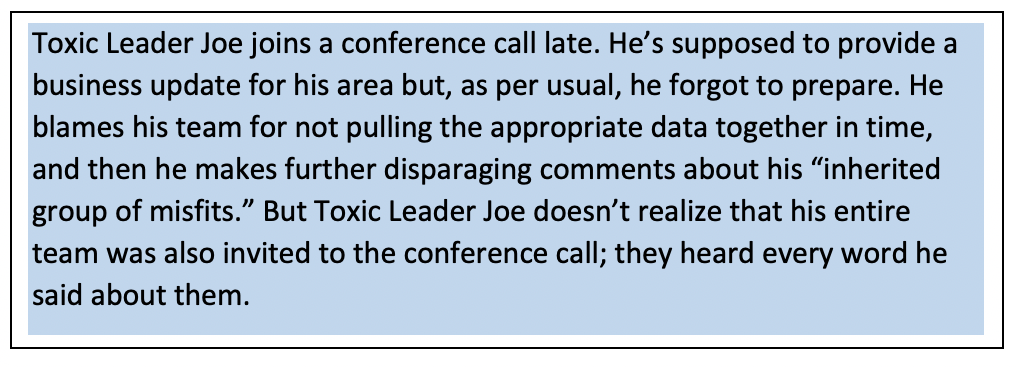Everyone knows what a toxic leader looks and sounds like. Their characteristics are unfortunately too common in corporate life today. These leaders create havoc and chaos; they drain the room of positive energy; they are narcissists, bullies, feckless cowards and often incompetent.
But a new corporate character has now emerged: the zombie employee. Toxic leaders and zombie employees are inextricably linked because one creates the other. Zombie employees emerge as a result of toxic leaders.
What are Zombie Employees?
These employees have become completely and unrepentantly checked out because of horrific leadership, betrayal and mismanagement.
Zombie employees have a tacit agreement with each other to do the absolute bare minimum. They lower the productivity bar to the point where coming in and turning on the lights is considered ambitious behavior.
Example of a Toxic Leader Creating Zombie Employees

There is usually a string of events similar to the above example that push employees to a zombie-like state.
They are beyond the point of hate or contempt for their toxic leader. And what comes after hate or contempt? Total, unmitigated apathy. They just don’t care anymore! They don’t actively plot or conspire towards the demise of their toxic leader — that would require them to be both organized and engaged. They don’t care enough to engender any of the traditional or classic work emotions such as antipathy, loathing or abhorrence. They no longer list or catalogue their individual grievances. Zombie employees have transcended far beyond caring and have taken up residence in the apathy motel, a place where no one gives a damn.
What are the Characteristics of a Zombie Employee?
- They arrive at work as late as possible and leave as early as they can.
- They take long lunches and consistently return from meetings late.
- They never ask questions, correct mistakes or share insights during team meetings.
- They never stay late except to take care of personal business using office equipment and supplies.
- They never do anything that makes their leader look good.
- They push all deadlines to the very end. Nothing is ever completed early.
- Their quality of work is what you’d expect: painfully pedestrian, no frills, just the bare essentials.
- They are consistently uninquisitive and supine; they display a dearth of intuitive competence.
- They are essentially dead behind the eyes, completely disconnected.
The Price of Retaining Toxic Leaders
It’s fascinating how long companies hold on to toxic leaders. They don’t seem to understand the price they pay for this. The number one reason a star performer leaves a company is bad leadership.
Some companies not only retain toxic leaders, they promote them. A guaranteed way of fusing dysfunctionality to a company’s culture is to reward bad behavior. Other employees will mimic this flawed behavior because the company has unwittingly telegraphed to them that it’s a recipe for success.
Many successful companies have an unofficial no-jerk policy. They understand that one bad leader has a domino effect and can ultimately impact the bottom line and tarnish their culture. They also realize that it becomes increasingly difficult to retain and attract key talent when you have toxic leaders in positions of power, which can impact the careers of promising high-potential employees. In these situations, zombie employees have been let down not only by their toxic leader but also by their company.
Ways to Avoid Creating Zombie Employees
- Conduct annual 360-degree performance feedback reviews on anyone who manages people. This will allow you to catch toxic leaders early.
- Conduct employee engagement surveys. You can gauge the pulse of your employee population and quickly identify troubled departments.
- Arrange for high-potential employees to have mentors and coaches outside of their immediate department or division.
- Offer various options for employees to raise concerns or seek other internal opportunities, e.g. HR, transfers, internal job postings, conflict-resolution processes.
- Invest in the recruiting process to better screen-out toxic leaders.
- Offer leadership development programs to train and improve people skills not just for current leaders but also for future leaders.
Related: 25 Clues You're Good at Your Job



